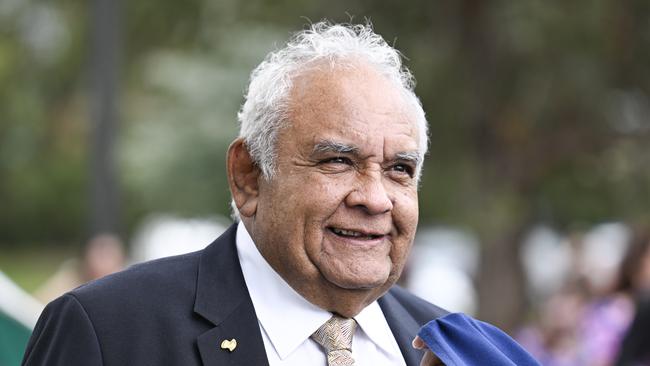Tom Calma call to change Indigenous Closing the Gap strategy
The Aboriginal elder who introduced the Closing the Gap concept as a way to measure and reduce Indigenous disadvantage is urging a shift in the approach.

The Aboriginal elder who introduced the Closing the Gap concept as a way to measure and reduce Indigenous disadvantage is urging a shift in the approach.
The decade-long national agreement on Closing the Gap signed in 2020 includes a promise to invest heavily in community-controlled Aboriginal organisations so they can do the work in key areas, including Indigenous health, child protection and crime prevention. This is based on evidence that results are often better when the service provider is a local Aboriginal organisation with locals on its board.
However, Tom Calma, whose 2005 social justice report inspired Kevin Rudd to create the first Closing the Gap agreement, says community-controlled organisations should not be bolstered at the expense of all else.
The former social justice commissioner says big numbers of Indigenous Australians use mainstream services and there should be a focus on ensuring those deliver what they are paid to deliver.
“Those community-controlled organisations by and large deliver a great service but we need to look at a move away from just investing in community-controlled Indigenous organisations and work much more with the private and public systems to ensure their services are culturally sound and safe,” Professor Calma told The Australian on Tuesday.
The latest Closing the Gap agreement has 17 targets, with just four on track to be met by the deadline in 2031. Those are targets for increased numbers of Indigenous children enrolled in early childhood education; Indigenous people in employment; Indigenous babies born a healthy weight; and increases in the area of land and sea subject to traditional owners’ rights or interests.
Annual data shows improvements in some targets but not enough to be considered on track. Four targets are unlikely to be met because results are getting worse – Indigenous suicide is increasing, the proportion of Indigenous adults in jail is rising, the proportion of Indigenous children in state care is climbing, and the percentage of Indigenous children who are developmentally ready for year 1 is going backwards.
There was also limited success at the end of the first Closing the Gap agreement.
Just two of the seven targets set in 2008 – early childhood education and year 12 attainment – were achieved after 10 years.
Ambitions failed in targets for school attendance, child mortality, employment, life expectancy and literacy and numeracy.
Professor Calma, national coordinator of the Department of Health and Aged Care’s tackling Indigenous smoking program, said Indigenous people relied on mainstream health system for services such as cancer treatment and psychological care.
He said a Closing the Gap priority was to build the capacity of the community-controlled sector but “that doesn’t mean you do that at the exclusion of all others because the majority of money directed to Aboriginal and Torres Strait Islander peoples is in the mainstream system”.
The Coalition of Peaks, an alliance of about 70 Indigenous organisations, is working with governments to roll out all elements of the Closing the Gap agreement.
It describes the second iteration of Closing the Gap as “fundamentally a new way of developing and implementing policies and programs that impact on the lives of Aboriginal and Torres Strait Islander people”.
A spokesperson for the Coalition of Peaks told The Australian on Tuesday that Closing the Gap was about changing the way governments worked across the board, not just with the community-controlled sector.
The agreement signed by all governments included a promise to reform government-funded mainstream services and organisations and to make them more accountable for delivering better outcomes for all Aboriginal and Torres Strait Islander people, the spokesperson said.
“The Coalition of Peaks are working hard to hold governments to account for their commitments. This includes ensuing that much more funding is provided to Aboriginal and Torres Strait Islander needs and services through mainstream funding agreements.
“That said, we know many Aboriginal and Torres Strait Islander people prefer Aboriginal and Torres Strait Islander community-controlled organisations as they deliver services that our people feel are culturally safe and responsive. In health, there is a community-controlled network of 550 clinics across Australia, serving more than half the Aboriginal and Torres Strait Islander population.”
More than 140,000 Aboriginal and Torres Strait Islander people reported wanting access to a community-controlled health service but there was not one in their area. This is why boosting community-controlled organisations was important, the spokesperson said.




To join the conversation, please log in. Don't have an account? Register
Join the conversation, you are commenting as Logout